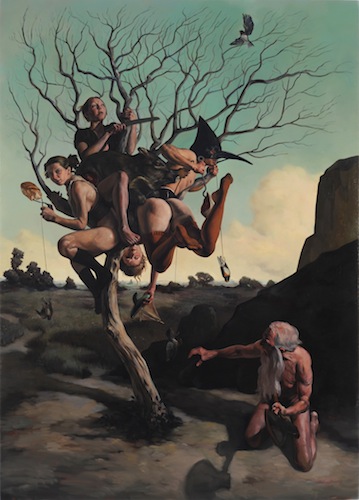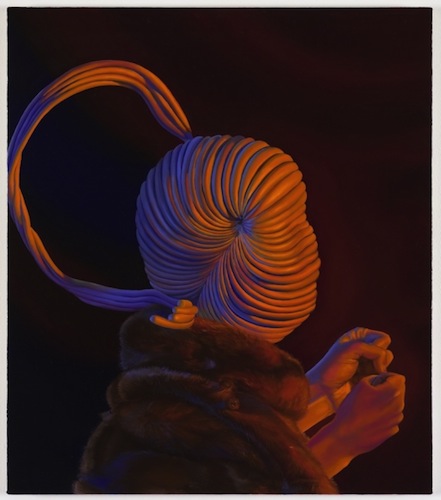Gilding and oil paint glimmer in the Baltimore Museum of Art’s galleries of European art from the fifteenth through nineteenth centuries, providing a subtle framing element for the temporary exhibition Surreal Selves in the newly renovated Contemporary wing. The exhibit features the paintings of Sascha Braunig, Erik Thor Sandberg and Aya Uekawa, united by distinctly anachronistic styles and their compelling ability to evoke modern issues, like environmentalism, psychology, social mores, and constructed ideas about physical beauty.
 Receptivity by Erik Thor Sandberg
Receptivity by Erik Thor Sandberg
Upon entering Surreal Selves, two panels by Sandberg peel away from the entranceway like wings, leading the eye around before drawing the body in, too. The curve of these panels emphasizes the distance in Sandberg’s landscapes—pushing the smoky, atmospheric sfumato treatment of the landscape away and driving the figure of a young woman and her animal companions into the viewer’s space. Receptivity toys with the duality, promise and bleakness, of human nature and the world we inhabit. The woman sits on a girder, situated on a rocky peak, as if a long-ago highway had crumbled away. Otherwise the landscape lacks human intrusion, suggesting utopian renewal in a post-apocalyptic era.
From the lower level of the panel, birds flock towards the woman and perch on and around her. They wait to be fed like pigeons around a senior citizen in Central Park. In a detail that could be considered ‘charming,’ a finch gently lifts a lock of the woman’s hair. After an initial look, other, not so pleasant, details emerge. What first appear to be multicolored pebbles are in fact the eggs of these birds. The eggs are being eaten, stolen and maliciously destroyed by birds that are not normally scavengers—such as a flamingo that attempts to crush one egg. A few such birds reverse the food chain by picking at the carcass of a vulture. As symbols of human nature, these birds warn against their own version of Mutually Assured Destruction—none of these myriad species shall live if they fight for resources.
Golden Uekawa paintings flank Sandberg’s panels and a line of Braunig’s bust portraits marches across the opposite wall. Uekawa prepares her supports so that they glimmer with gold leaf and then floats single, female figures with fluid, snake-like hair on their surfaces. The eyes of Uekawa’s women are both vacant and penetrating, evoking Christian martyrs. There are qualities about Braunig’s busts that are distinctly female, but most of their bodies are fully covered—Bossy Pins and Collared both wear enlarged Elizabethan ruffs; an intestinal growth swallows the head of Fister; and Untitled blends into its striped clothes and backdrop like a chameleon. While Braunig and Uekawa are equally cerebral and technically skilled compared to Sandberg, the single figures against simple backdrops painted by the former two are not as engaging as the more complex compositions of the latter.
The wall panel for Surreal Selves is located in the middle of this gallery, so viewers must either go without textual information for a while or interrupt the flow of their visit. This inconvenience seems in accord with Contemporary Art Curator Kristen Hileman’s decision to limit the object labels in this gallery to tombstone information, allowing viewers to think freely and form their own opinions of the art. It is worth noting that the curator chose three artists under age forty and one (Sandberg) who works and exhibits in proximity to the museum in Washington, D.C. Young artists, especially outside New York, are not frequently allotted opportunities to show in major museums.
Hileman has also skillfully positioned a large, gold canvas by Uekawa, The Brazen Bull, in a small, adjoining gallery, so that it lures viewers into this otherwise detached space. Four large canvases—two each by Sandberg and Uekawa—dominate this petite space, but half are visually disconnected from other examples of the artists’ work. The Muffled Desire has a rich, black ground, unlike Uekawa’s other paintings in this exhibition. While this doesn’t detract from the quality of the individual painting—featuring a woman with blue-gray fur covering her body, whose pose is reminiscent of Venus in Botticelli’s Primavera—the lack of didactics leaves me wondering why the artist chose to change her backdrop and why the curator chose to include this painting. Similarly, Blinded is Sandberg’s only painting in this show that does not include multiple figures in a complex, symbol-laden landscape.
The overall tone of the paintings in Surreal Selves is dark—Uekawa’s gold leaf backgrounds form the highest key in the two rooms. This suits the psychologically dark, Surrealist content of fantastic figuration and nightmarish, personal signification that Hileman advances, but the significance of this show lies further back in art history. All three of the artists in Surreal Selves work in traditional, naturalistic, figurative styles and reference European techniques from the Medieval, Renaissance and Baroque periods—Uekawa’s paintings evoke the preparation and hagiography of fifteenth century, Italian church panels; Braunig’s busts suggest Renaissance noblewomen with their collars, rich draperies and furs; and all of Sandberg’s woman recall the coy, hairless nudes of Cranach the Elder, while his men resemble the old but muscular saints of Caravaggio.
These art historical allusions and techniques beg the question: why, more than a century and a half after photography freed artists from the need to paint realistically, do these artists paint in such a manner? The answer lies in the technique itself. The artists in Surreal Selves have created a balance of technical skill and intricate visual detail that draws the viewer in and keeps their interest.
Additionally, the idea can be in the technique. Painting on a white ground—as Renaissance artists did—represents a human marring of a perfect surface. However, painting up from a dark ground—like Caravaggio—marks the emergence of human light and creative ability from a hostile world. In contrast, modern preferences for nonrepresentational painting expose latent, Greenbergian desires for ‘purified’ art forms. Like photography at the other end of the spectrum, minimalist abstraction doesn’t necessitate technical painting prowess. By choosing to engage art history, the artists in Surreal Selves avoid the extremes of representation that might weaken their ability to attract an audience and convey content.
Author Aden Weisel holds a degree in Art History, Theory and Criticism with a concentration in Curatorial Studies from the Maryland Institute College of Art. Her research has largely focused on the treatment of African art within Euro-American museums.










